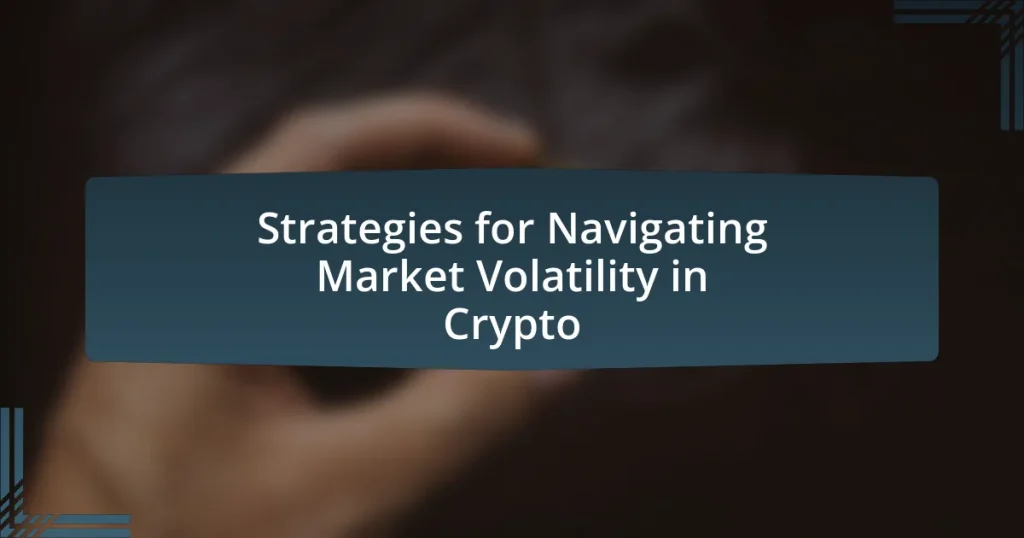The article focuses on strategies for navigating market volatility in the cryptocurrency sector. It outlines key approaches such as diversification, risk management, and technical analysis, which help investors mitigate risks and make informed decisions during price fluctuations. The discussion includes methods for assessing market volatility, effective use of indicators, and the importance of emotional discipline. Additionally, it covers trading strategies, the impact of external factors like regulatory changes and macroeconomic trends, and best practices for managing investments during volatile periods. Overall, the article provides a comprehensive framework for investors to enhance their resilience and performance in the unpredictable crypto market.

What are the key strategies for navigating market volatility in crypto?
Key strategies for navigating market volatility in crypto include diversification, risk management, and utilizing technical analysis. Diversification involves spreading investments across various cryptocurrencies to mitigate risk; for instance, holding Bitcoin, Ethereum, and several altcoins can reduce the impact of a single asset’s price drop. Risk management techniques, such as setting stop-loss orders, help limit potential losses during sudden market downturns. Additionally, employing technical analysis allows traders to identify trends and make informed decisions based on historical price movements, which can be crucial during volatile periods. These strategies are supported by the fact that diversified portfolios tend to perform better in unpredictable markets, as evidenced by studies showing that diversification can reduce risk without sacrificing returns.
How can investors assess market volatility in the crypto space?
Investors can assess market volatility in the crypto space by analyzing historical price movements, utilizing volatility indicators, and monitoring market sentiment. Historical price movements provide insights into past volatility patterns, allowing investors to identify trends and potential future fluctuations. Volatility indicators, such as the Bollinger Bands and the Average True Range (ATR), quantitatively measure price variability, helping investors gauge the level of market risk. Additionally, monitoring market sentiment through social media trends and news can reveal investor behavior and potential market shifts, as sentiment often correlates with price volatility. For instance, during significant market events, such as regulatory announcements or technological advancements, sentiment analysis can predict increased volatility.
What indicators are most useful for measuring crypto market volatility?
The most useful indicators for measuring crypto market volatility include the Average True Range (ATR), Bollinger Bands, and the VIX (Volatility Index). The Average True Range quantifies market volatility by measuring the range between the high and low prices over a specific period, providing insights into price fluctuations. Bollinger Bands consist of a moving average and two standard deviation lines, which expand and contract based on market volatility, indicating potential price movements. The VIX, often referred to as the “fear index,” reflects market expectations of future volatility based on options pricing, serving as a benchmark for market sentiment. These indicators are widely recognized in financial analysis for their effectiveness in assessing volatility in the cryptocurrency market.
How do historical trends inform current volatility assessments?
Historical trends inform current volatility assessments by providing a framework for understanding price fluctuations and market behavior over time. Analyzing past market data, such as the Bitcoin price movements during the 2017 bull run and subsequent corrections, reveals patterns that can predict future volatility. For instance, the historical correlation between market sentiment and price changes indicates that periods of rapid price increases are often followed by significant corrections, as seen in the 2018 market downturn. This historical context allows analysts to gauge potential volatility by examining similar conditions and responses in the market, thereby enhancing risk management strategies in the crypto space.
What role does risk management play in crypto volatility strategies?
Risk management is essential in crypto volatility strategies as it helps investors mitigate potential losses during price fluctuations. By implementing risk management techniques such as setting stop-loss orders, diversifying portfolios, and employing position sizing, traders can protect their capital from extreme market movements. For instance, a study by the CFA Institute highlights that effective risk management can reduce the impact of volatility on investment returns, emphasizing its importance in the highly unpredictable cryptocurrency market.
How can investors set effective stop-loss orders?
Investors can set effective stop-loss orders by determining a specific price point at which they will sell an asset to prevent further losses. This involves analyzing the asset’s historical price movements and volatility to establish a stop-loss level that aligns with their risk tolerance. For instance, a common strategy is to set a stop-loss order at 5-10% below the purchase price, which allows for minor fluctuations while protecting against significant downturns. Research indicates that using stop-loss orders can reduce emotional decision-making and help maintain a disciplined trading strategy, as evidenced by a study from the Journal of Finance, which found that traders who employed stop-loss strategies experienced lower average losses compared to those who did not.
What are the best practices for portfolio diversification in crypto?
The best practices for portfolio diversification in crypto include spreading investments across various cryptocurrencies, utilizing stablecoins, and incorporating different asset classes such as DeFi tokens and NFTs. By diversifying across multiple cryptocurrencies, investors can mitigate risks associated with the volatility of individual assets, as evidenced by the fact that Bitcoin and Ethereum often exhibit different price movements. Additionally, stablecoins can provide a buffer during market downturns, allowing for liquidity without exposure to high volatility. Incorporating various asset classes, such as DeFi tokens, can further enhance diversification, as these assets may respond differently to market conditions, thereby reducing overall portfolio risk.
How can emotional discipline help in volatile markets?
Emotional discipline helps in volatile markets by enabling traders to make rational decisions rather than impulsive ones. In the context of cryptocurrency, where price swings can exceed 10% in a single day, maintaining emotional control allows investors to stick to their trading strategies and avoid panic selling or overreacting to market fluctuations. Research indicates that traders with high emotional discipline tend to achieve better long-term performance, as they are less likely to fall victim to cognitive biases such as loss aversion or herd mentality, which can lead to poor investment choices.
What techniques can traders use to manage emotions during market swings?
Traders can manage emotions during market swings by employing techniques such as setting predefined trading plans, utilizing stop-loss orders, and practicing mindfulness. Predefined trading plans help traders stick to their strategies, reducing impulsive decisions driven by fear or greed. Stop-loss orders automatically limit potential losses, providing a safety net that alleviates emotional stress during volatile periods. Mindfulness practices, such as meditation or deep-breathing exercises, can enhance emotional regulation, allowing traders to maintain focus and clarity amidst market fluctuations. These techniques are supported by research indicating that structured approaches and emotional awareness can significantly improve trading performance and decision-making.
How does maintaining a long-term perspective mitigate volatility impacts?
Maintaining a long-term perspective mitigates volatility impacts by allowing investors to ride out short-term fluctuations and focus on the overall growth potential of their investments. Historical data shows that markets, including cryptocurrencies, tend to recover from downturns over time; for instance, Bitcoin has experienced multiple significant price corrections but has consistently reached new highs in subsequent years. This long-term view reduces the emotional response to market swings, enabling more rational decision-making and minimizing the likelihood of panic selling during downturns.

What specific trading strategies can be employed during market volatility?
During market volatility, specific trading strategies such as scalping, trend following, and options trading can be effectively employed. Scalping involves making numerous small trades to capitalize on minor price fluctuations, which is particularly useful in volatile markets where rapid price changes occur. Trend following focuses on identifying and trading in the direction of prevailing market trends, allowing traders to benefit from sustained price movements. Options trading provides the ability to hedge against potential losses or to speculate on price movements with limited risk, making it a strategic choice during uncertain market conditions. These strategies are validated by their widespread use among traders who seek to manage risk and maximize returns in fluctuating markets.
How does day trading differ from long-term investing in volatile markets?
Day trading involves executing multiple trades within a single day to capitalize on short-term price movements, while long-term investing focuses on holding assets for extended periods to benefit from overall market growth. In volatile markets, day traders rely on technical analysis and real-time data to make quick decisions, often using leverage to amplify gains, which increases risk. Conversely, long-term investors typically analyze fundamental factors and market trends, aiming to withstand short-term fluctuations and benefit from the asset’s long-term appreciation. Historical data shows that day trading can lead to significant losses due to rapid market changes, whereas long-term investing has historically yielded positive returns over time, as evidenced by the S&P 500’s average annual return of about 10% over several decades.
What are the advantages and disadvantages of day trading in crypto?
Day trading in crypto offers the advantage of potential high returns due to the market’s volatility, allowing traders to capitalize on price fluctuations within short time frames. This strategy enables traders to make quick profits, as evidenced by the fact that Bitcoin’s price can change by over 10% in a single day, providing numerous trading opportunities.
However, day trading also comes with significant disadvantages, including the high risk of losses and the emotional stress associated with rapid decision-making. Research indicates that approximately 90% of day traders lose money, highlighting the challenges of consistently making profitable trades in a highly unpredictable market. Additionally, the need for constant monitoring and quick execution can lead to burnout and poor mental health.
How can traders identify optimal entry and exit points in volatile conditions?
Traders can identify optimal entry and exit points in volatile conditions by utilizing technical analysis tools such as support and resistance levels, moving averages, and volatility indicators like the Average True Range (ATR). These tools help traders gauge market sentiment and price movements. For instance, support and resistance levels indicate where prices may reverse, while moving averages can signal trends. The ATR quantifies volatility, allowing traders to set stop-loss orders effectively. Historical data shows that traders employing these methods can improve their decision-making, as evidenced by studies indicating that technical analysis can enhance trading performance in volatile markets.
What is the significance of technical analysis in volatile markets?
Technical analysis is significant in volatile markets as it provides traders with tools to identify price trends and potential reversal points. In highly fluctuating environments, such as cryptocurrency markets, technical analysis utilizes historical price data and trading volume to forecast future price movements. For instance, studies have shown that patterns like moving averages and support/resistance levels can help traders make informed decisions, reducing the risk associated with rapid price changes. This analytical approach allows traders to react swiftly to market dynamics, enhancing their ability to capitalize on short-term opportunities while managing risk effectively.
Which technical indicators are most effective for crypto trading?
The most effective technical indicators for crypto trading include the Moving Average Convergence Divergence (MACD), Relative Strength Index (RSI), and Bollinger Bands. MACD helps identify momentum and trend direction by showing the relationship between two moving averages of a security’s price. RSI measures the speed and change of price movements, indicating overbought or oversold conditions, which can signal potential reversals. Bollinger Bands provide a visual representation of volatility and price levels, helping traders identify potential breakout or reversal points. These indicators are widely used due to their ability to provide insights into market trends and price movements, making them valuable tools for traders navigating the volatile crypto market.
How can chart patterns help predict price movements during volatility?
Chart patterns can help predict price movements during volatility by providing visual representations of historical price behavior, which traders use to identify potential future trends. For instance, patterns such as head and shoulders, flags, and triangles indicate market sentiment and potential reversals or continuations. Historical data shows that these patterns have a statistical probability of success; for example, a study by Bulkowski in “Encyclopedia of Chart Patterns” indicates that head and shoulders patterns have a success rate of approximately 70% in predicting price reversals. This predictive capability allows traders to make informed decisions during volatile market conditions, enhancing their ability to navigate price fluctuations effectively.
What are the benefits of using automated trading systems in volatile markets?
Automated trading systems provide several benefits in volatile markets, including enhanced speed, improved accuracy, and emotion-free trading. These systems can execute trades within milliseconds, allowing traders to capitalize on rapid price movements that characterize volatile markets. Additionally, automated systems utilize algorithms that analyze market data and execute trades based on predefined criteria, reducing the risk of human error and increasing the likelihood of profitable trades. Furthermore, by removing emotional decision-making, automated trading systems help maintain a consistent trading strategy, which is crucial in unpredictable market conditions.
How do trading bots operate in response to market fluctuations?
Trading bots operate by analyzing market data and executing trades based on predefined algorithms in response to market fluctuations. These bots utilize technical indicators, price trends, and trading signals to make real-time decisions, allowing them to capitalize on rapid changes in the market. For instance, a trading bot may be programmed to buy when the price drops below a certain threshold and sell when it rises above a specified level, effectively responding to volatility. This automated approach enables traders to react faster than manual trading, which is crucial in the highly volatile cryptocurrency market, where prices can change dramatically within seconds.
What should investors consider when selecting a trading bot for crypto?
Investors should consider the trading bot’s performance history, security features, and customization options when selecting a trading bot for crypto. A bot with a proven track record of profitability and consistent returns can indicate reliability; for instance, bots that have been backtested against historical data often provide insights into their potential effectiveness. Security is crucial, as investors need to ensure that the bot employs robust encryption and two-factor authentication to protect their assets. Additionally, customization options allow investors to tailor strategies to their risk tolerance and market conditions, enhancing the bot’s adaptability to market volatility.

What external factors influence market volatility in crypto?
External factors that influence market volatility in crypto include regulatory changes, macroeconomic trends, technological advancements, and market sentiment. Regulatory changes, such as government crackdowns or new legislation, can lead to sudden price fluctuations; for instance, China’s ban on cryptocurrency transactions in 2021 caused significant market drops. Macroeconomic trends, including inflation rates and interest rates, also impact investor behavior and market stability. Technological advancements, such as security breaches or upgrades to blockchain protocols, can create uncertainty and volatility. Lastly, market sentiment, driven by news events and social media trends, can lead to rapid buying or selling, further exacerbating price swings.
How do regulatory changes impact crypto market stability?
Regulatory changes significantly impact crypto market stability by influencing investor confidence and market behavior. When governments introduce new regulations, such as stricter compliance requirements or outright bans, it can lead to increased volatility as traders react to the uncertainty. For instance, the announcement of China’s ban on cryptocurrency transactions in 2021 resulted in a sharp decline in Bitcoin’s price, demonstrating how regulatory actions can trigger immediate market reactions. Conversely, positive regulatory developments, like the approval of Bitcoin ETFs in the United States, can enhance market stability by attracting institutional investment and fostering a more structured trading environment. Thus, the nature of regulatory changes—whether restrictive or supportive—directly correlates with the stability of the crypto market.
What recent regulations have affected crypto volatility?
Recent regulations impacting crypto volatility include the European Union’s Markets in Crypto-Assets (MiCA) framework, which aims to provide a comprehensive regulatory environment for cryptocurrencies. This regulation, set to be fully implemented by 2024, introduces clear guidelines for crypto asset service providers, enhancing investor protection and market integrity. Additionally, the U.S. Securities and Exchange Commission (SEC) has increased scrutiny on crypto exchanges and initial coin offerings (ICOs), leading to heightened compliance requirements. These regulatory measures contribute to reduced speculative trading and increased market stability, thereby influencing overall crypto volatility.
How can investors stay informed about regulatory developments?
Investors can stay informed about regulatory developments by regularly monitoring official government websites, financial regulatory agencies, and industry news outlets. These sources provide timely updates on changes in regulations that affect the cryptocurrency market. For instance, the U.S. Securities and Exchange Commission (SEC) and the Commodity Futures Trading Commission (CFTC) frequently publish press releases and reports that outline new regulations and enforcement actions. Additionally, subscribing to newsletters from reputable financial news organizations can help investors receive curated information directly related to regulatory changes in the crypto space.
What role do macroeconomic factors play in crypto market volatility?
Macroeconomic factors significantly influence crypto market volatility by affecting investor sentiment and market dynamics. For instance, changes in interest rates, inflation rates, and economic growth indicators can lead to shifts in capital flows, impacting demand for cryptocurrencies. Historical data shows that during periods of economic uncertainty, such as the COVID-19 pandemic, cryptocurrencies experienced heightened volatility as investors reacted to macroeconomic news and trends. Additionally, regulatory developments and monetary policy decisions can create abrupt price movements, further illustrating the connection between macroeconomic factors and crypto market fluctuations.
How do interest rates and inflation affect cryptocurrency prices?
Interest rates and inflation significantly influence cryptocurrency prices by affecting investor sentiment and capital flow. When interest rates rise, traditional investments like bonds become more attractive, leading to a potential decrease in demand for cryptocurrencies as investors seek safer, interest-bearing assets. For instance, in 2022, the Federal Reserve’s interest rate hikes correlated with a decline in Bitcoin prices, illustrating this relationship. Conversely, high inflation often drives investors toward cryptocurrencies as a hedge against currency devaluation, increasing demand and potentially raising prices. Historical data shows that during periods of high inflation, such as in the 1970s, alternative assets like gold and, more recently, cryptocurrencies have seen increased interest as stores of value.
What global events have historically influenced crypto market volatility?
Global events that have historically influenced crypto market volatility include regulatory announcements, economic crises, technological advancements, and geopolitical tensions. For instance, the 2017 Chinese government crackdown on cryptocurrency exchanges led to a significant drop in Bitcoin’s price, illustrating how regulatory changes can create immediate market reactions. Similarly, the COVID-19 pandemic in 2020 caused widespread economic uncertainty, resulting in increased volatility as investors sought safe-haven assets, including cryptocurrencies. Additionally, technological developments, such as the Ethereum network upgrade in 2021, can lead to price fluctuations based on market speculation and investor sentiment. Geopolitical events, like conflicts or sanctions, also impact investor confidence and can drive volatility in the crypto markets.
How can investors prepare for unexpected market events?
Investors can prepare for unexpected market events by diversifying their portfolios across various asset classes, including cryptocurrencies, stocks, and bonds. Diversification reduces risk by ensuring that not all investments are affected by a single market event. Historical data shows that during the 2020 market crash, diversified portfolios experienced less volatility and quicker recovery compared to concentrated investments. Additionally, maintaining a cash reserve allows investors to capitalize on buying opportunities during market downturns, as evidenced by the rebound of Bitcoin prices after significant drops in 2018 and 2020. Regularly reviewing and adjusting investment strategies based on market conditions further enhances preparedness for unforeseen events.
What contingency plans should be in place for sudden market shifts?
Contingency plans for sudden market shifts in crypto should include diversified asset allocation, liquidity management, and predefined exit strategies. Diversified asset allocation reduces risk by spreading investments across various cryptocurrencies and traditional assets, which can mitigate losses during downturns. Liquidity management ensures that sufficient cash or liquid assets are available to capitalize on opportunities or cover losses quickly, as evidenced by the rapid price fluctuations seen in the crypto market. Predefined exit strategies, such as stop-loss orders, allow investors to limit potential losses by automatically selling assets when they reach a certain price, a tactic that has proven effective during past market corrections.
How can staying informed about market news reduce volatility risks?
Staying informed about market news can significantly reduce volatility risks by enabling investors to make timely and informed decisions. When investors are aware of economic indicators, regulatory changes, and market sentiment, they can anticipate potential market movements and adjust their strategies accordingly. For instance, a study by the CFA Institute found that timely access to market information can lead to better investment outcomes, as informed investors are less likely to react impulsively to sudden price changes. This proactive approach helps stabilize the market by reducing panic selling and fostering a more rational trading environment.
What are the best practices for managing investments during volatile periods?
The best practices for managing investments during volatile periods include diversifying your portfolio, maintaining a long-term perspective, and employing risk management strategies. Diversification reduces risk by spreading investments across various assets, which can mitigate losses when certain markets decline. Maintaining a long-term perspective helps investors avoid panic selling during downturns, as historically, markets tend to recover over time. Employing risk management strategies, such as setting stop-loss orders and regularly rebalancing the portfolio, can protect against significant losses and ensure that investments align with risk tolerance. These practices are supported by historical data showing that diversified portfolios tend to perform better during market fluctuations, as evidenced by studies from financial institutions like Vanguard and BlackRock.
How can regular portfolio reviews help in volatile markets?
Regular portfolio reviews can help investors adapt their strategies in volatile markets by allowing them to assess performance, realign goals, and mitigate risks. In the context of cryptocurrency, where price fluctuations can be extreme, frequent evaluations enable investors to identify underperforming assets and make timely adjustments. For instance, a study by the CFA Institute highlights that systematic portfolio reviews can lead to improved decision-making and better risk management, particularly in unpredictable environments. This proactive approach ensures that investors remain aligned with their investment objectives and can capitalize on market opportunities while minimizing potential losses.
What strategies can be employed to capitalize on market dips?
To capitalize on market dips, investors can employ strategies such as dollar-cost averaging, buying the dip, and utilizing stop-loss orders. Dollar-cost averaging involves consistently investing a fixed amount of money at regular intervals, which mitigates the impact of volatility by spreading out purchases over time. Buying the dip refers to purchasing assets when their prices have fallen significantly, based on the belief that they will recover, a strategy supported by historical trends showing that many cryptocurrencies rebound after dips. Utilizing stop-loss orders helps limit potential losses by automatically selling an asset when it reaches a predetermined price, thus protecting capital during downturns. These strategies are effective in navigating the inherent volatility of the cryptocurrency market.










